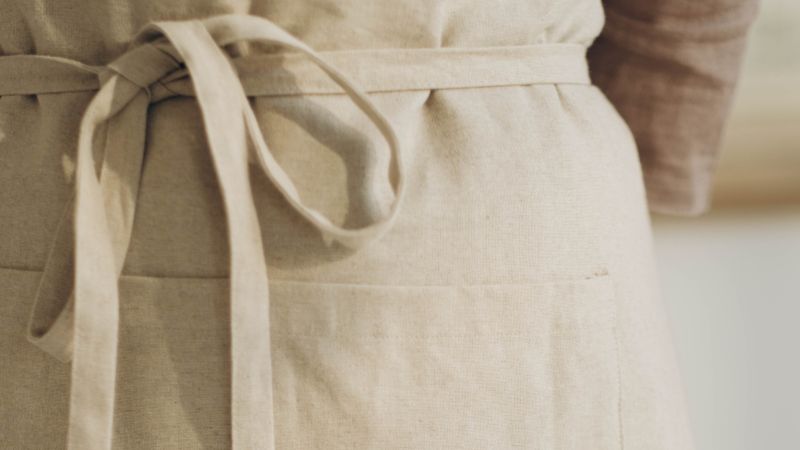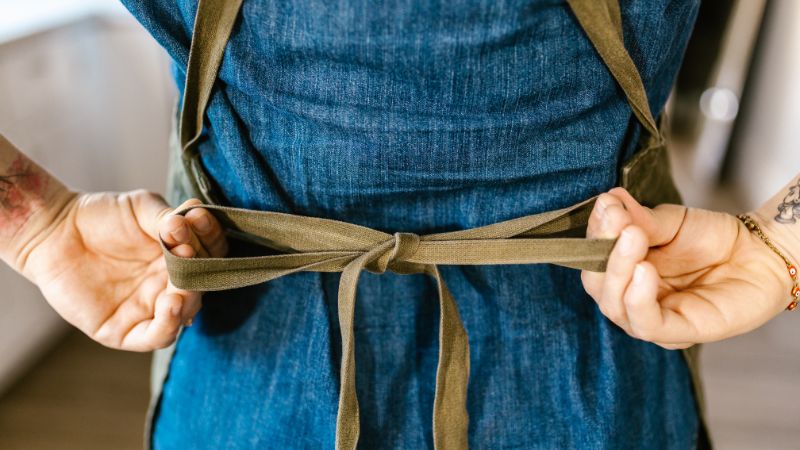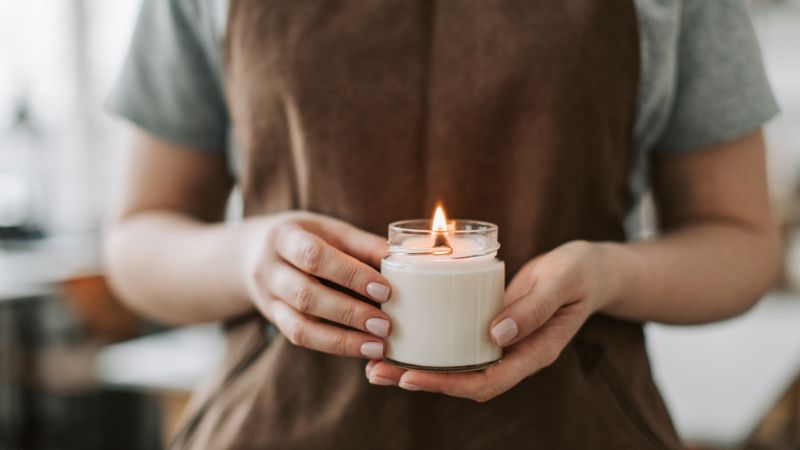
What are the Different Apron Types?
Bib Aprons
Bib aprons are the most common and versatile type you’ll encounter. They cover your chest and extend down to your knees, providing maximum protection from spills and splatters.
These aprons typically feature a loop that goes around your neck and ties at the waist. Many professional chefs prefer bib aprons because they shield the entire front of your clothing.
Bib aprons come in different materials like cotton, polyester, and even leather for specialized uses.
Some modern versions offer cross-back straps instead of neck loops to reduce strain during long cooking sessions.
Look for bib aprons with pockets if you need to keep utensils, recipe cards, or a towel handy while you work.
Waist Aprons
Waist aprons, also called bistro or server aprons, only cover from your waist down. They’re shorter than bib aprons and tie around your waist.
These aprons are popular in restaurants among servers because they allow freedom of movement while providing convenient pockets for order pads, pens, and tips.
Many waist aprons are designed with multiple pockets to keep everything organized.
Waist aprons typically come in different lengths – some extend to mid-thigh while others reach the knees. For kitchen use, a longer waist apron provides better protection.
They’re also easier to put on and take off quickly, making them practical when you need protection for quick cooking tasks.
Sleeveless and Other Styles
Cobbler aprons (also called smock aprons) offer coverage for both front and back without ties. These slip over your head like a vest and provide all-around protection.
These aprons are ideal if you need coverage but dislike ties or straps. They’re comfortable for extended wear and popular among crafters and artists.
Shop aprons, designed for woodworking and crafting, typically feature heavy-duty materials and many pockets for tools. They prioritize durability over style.
Selecting the Right Material
Cotton and Canvas Aprons
Cotton aprons are perfect for everyday kitchen use. They’re breathable, comfortable, and easy to clean. You can simply toss them in the washing machine when they get dirty.
Canvas aprons provide excellent durability for heavy-duty tasks. They’re thicker than cotton and can withstand more wear and tear.
Many professional chefs prefer canvas for its sturdiness and longevity.
Both materials come in different weights. Lighter cotton works well for light cooking or serving, while heavier canvas is better for activities like grilling or woodworking.
These natural fabrics get softer with each wash. They also absorb spills quickly, protecting your clothes underneath.
Polyester and Synthetic Aprons
Polyester aprons offer excellent stain resistance and quick-drying properties. They’re perfect if you work with colorful ingredients or liquids that might stain natural fabrics.
These synthetic materials are highly waterproof, making them ideal for dishwashing or messy food prep. Liquids bead up on the surface instead of soaking through.
Polyester blends often include other synthetic fibers for added benefits. Some have stretch components for better mobility while you work.
Maintenance is simple with synthetic aprons. They typically dry faster than cotton and don’t wrinkle as easily.
For hot environments, be aware that synthetic materials don’t breathe as well as natural fibers. However, many newer polyester blends are designed with improved ventilation features.
Choose polyester when you need a durable, water-resistant option that maintains its appearance through frequent use.
Considering Apron Size and Coverage

Full-Length Aprons for Maximum Protection
Full-length aprons provide comprehensive coverage from your chest down to your knees or below.
These aprons typically measure between 35-40 inches in length and are perfect when you need serious protection from spills and splashes.
If you work with messy ingredients or hot liquids, a full-length apron keeps your clothes safe. They’re ideal for intensive cooking sessions, art projects, or workshop tasks where protection is a priority.
Look for adjustable neck straps and waist ties to ensure a comfortable fit. Many full-length kitchen aprons come with pockets for storing tools, recipe cards, or your phone.
The extra coverage means more fabric, which might feel hot during lengthy cooking sessions.
Half-Length Aprons for Ease of Movement
Half-length or waist aprons typically measure between 18-30 inches and tie around your waist, leaving your upper body free. These shorter aprons offer greater mobility while still protecting your lower half.
They’re perfect for servers, baristas, or casual home cooking where you need to move quickly. The lighter design reduces heat and weight, making them more comfortable for extended wear.
Many waist aprons feature multiple pockets, which are handy for carrying order pads, pens, or small tools. They’re also easier to put on and take off quickly when you’re in a hurry.
For the best fit, measure around your waist and choose an apron with ties long enough to wrap around and tie comfortably in front.
Half-length aprons come in various widths too, from narrow server styles to wider cooking versions.
Choosing Aprons for Specific Uses

Professional Chef Aprons for Culinary Experts
Professional chef aprons need to withstand heavy use while providing maximum protection. Durability matters most here – look for reinforced stitching and heavyweight fabrics like canvas or denim.
Many professional aprons include specialized features like:
- Towel loops for quick access to hand towels
- Adjustable straps for a custom fit
- Multiple pockets to organize tools
- Knife slots for safe storage of cutting tools
The color of your chef apron matters too! Dark colors hide stains better, while white aprons are traditional in many professional kitchens and can be bleached clean.
Frequently Asked Questions
How can you determine the best apron size for a comfortable fit?
Measure around your chest at the fullest point for bib aprons. This ensures the top portion fits comfortably without pulling.
For waist aprons, measure around your natural waistline. Add a few inches to allow for movement and comfort while working.
Check the apron length by measuring from your chest or waist to where you want the apron to end. Most aprons hit at mid-thigh or knee level.
Look for adjustable neck and waist straps that let you customize the fit. Cross-back straps can distribute weight better for all-day comfort.
Could you provide tips on how to care for and maintain an apron?
Read the care label before washing your apron. Most cotton and polyester aprons can be machine washed, but specialty materials might need hand washing.
Treat stains quickly before they set. Pre-treat oil spots with dish soap and wash in the hottest water the fabric allows.
Hang your apron to dry rather than using a dryer when possible. This helps preserve the fabric and prevent shrinking.
Store aprons by hanging them rather than crumpling them in a drawer. This prevents deep wrinkles and keeps them ready for use.
